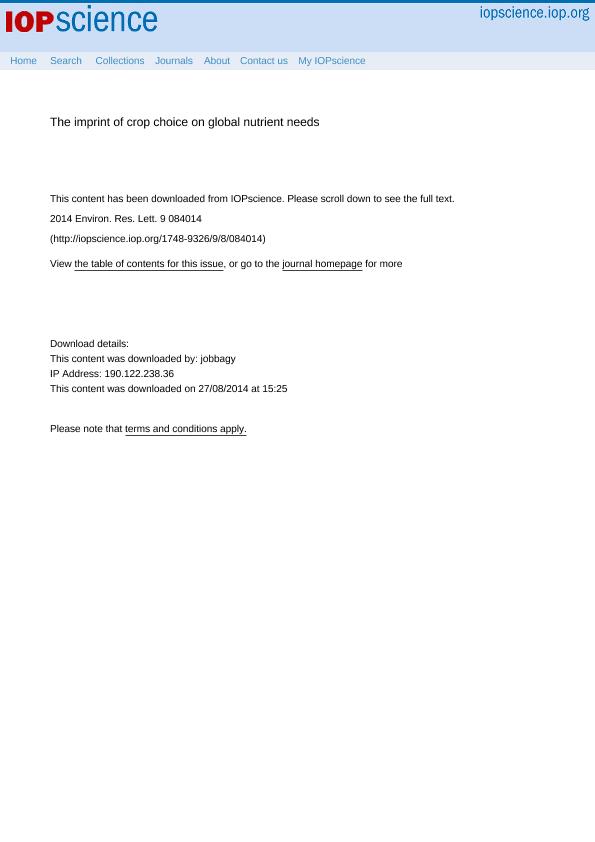Mostrar el registro sencillo del ítem
dc.contributor.author
Jobbagy Gampel, Esteban Gabriel

dc.contributor.author
Sala, Osvaldo Esteban

dc.date.available
2017-03-31T20:13:05Z
dc.date.issued
2014-08
dc.identifier.citation
Jobbagy Gampel, Esteban Gabriel; Sala, Osvaldo Esteban; The imprint of crop choice on global nutrient needs; Iop Publishing; Environmental Research Letters; 9; 8; 8-2014; 1-10; 084014-084014
dc.identifier.issn
1748-9326
dc.identifier.uri
http://hdl.handle.net/11336/14641
dc.description.abstract
Solutions to meet growing food requirements in a world of limited suitable land and degrading environment focus mainly on increasing crop yields, particularly in poorly performing regions, and reducing animal product consumption. Increasing yields could alleviate land requirements, but imposing higher soil nutrient withdrawals and in most cases larger fertilizer inputs. Lowering animal product consumption favors a more efficient use of land as well as soil and fertilizer nutrients; yet actual saving may largely depend on which crops and how much fertilizer are used to feed livestock versus people. We show, with a global analysis, how the choice of cultivated plant species used to feed people and livestock influences global food production as well as soil nutrient withdrawals and fertilizer additions. The 3 to 15-fold differences in soil nutrient withdrawals per unit of energy or protein produced that we report across major crops explain how composition shifts over the last 20 years have reduced N, maintained P and increased K harvest withdrawals from soils while contributing to increasing dietary energy, protein and, particularly, vegetable fat outputs. Being highly variable across crops, global fertilization rates do not relate to actual soil nutrient withdrawals, but to monetary values of harvested products. Future changes in crop composition could contribute to achieve more sustainable food systems, optimizing land and fertilizer use.
dc.format
application/pdf
dc.language.iso
eng
dc.publisher
Iop Publishing

dc.rights
info:eu-repo/semantics/openAccess
dc.rights.uri
https://creativecommons.org/licenses/by/2.5/ar/
dc.subject
Agriculture
dc.subject
Fertilization
dc.subject
Soil Nutrients
dc.subject.classification
Otras Ciencias de la Tierra y relacionadas con el Medio Ambiente

dc.subject.classification
Ciencias de la Tierra y relacionadas con el Medio Ambiente

dc.subject.classification
CIENCIAS NATURALES Y EXACTAS

dc.title
The imprint of crop choice on global nutrient needs
dc.type
info:eu-repo/semantics/article
dc.type
info:ar-repo/semantics/artículo
dc.type
info:eu-repo/semantics/publishedVersion
dc.date.updated
2017-03-31T18:13:42Z
dc.journal.volume
9
dc.journal.number
8
dc.journal.pagination
1-10; 084014-084014
dc.journal.pais
Reino Unido

dc.journal.ciudad
Londres
dc.description.fil
Fil: Jobbagy Gampel, Esteban Gabriel. Consejo Nacional de Investigaciones Científicas y Técnicas. Centro Científico Tecnológico San Luis. Instituto de Matemática Aplicada de San Luis; Argentina
dc.description.fil
Fil: Sala, Osvaldo Esteban. Arizona State University; Estados Unidos. Consejo Nacional de Investigaciones Científicas y Técnicas; Argentina
dc.journal.title
Environmental Research Letters

dc.relation.alternativeid
info:eu-repo/semantics/altIdentifier/url/http://iopscience.iop.org/article/10.1088/1748-9326/9/8/084014
dc.relation.alternativeid
info:eu-repo/semantics/altIdentifier/doi/http://dx.doi.org/10.1088/1748-9326/9/8/084014
Archivos asociados
